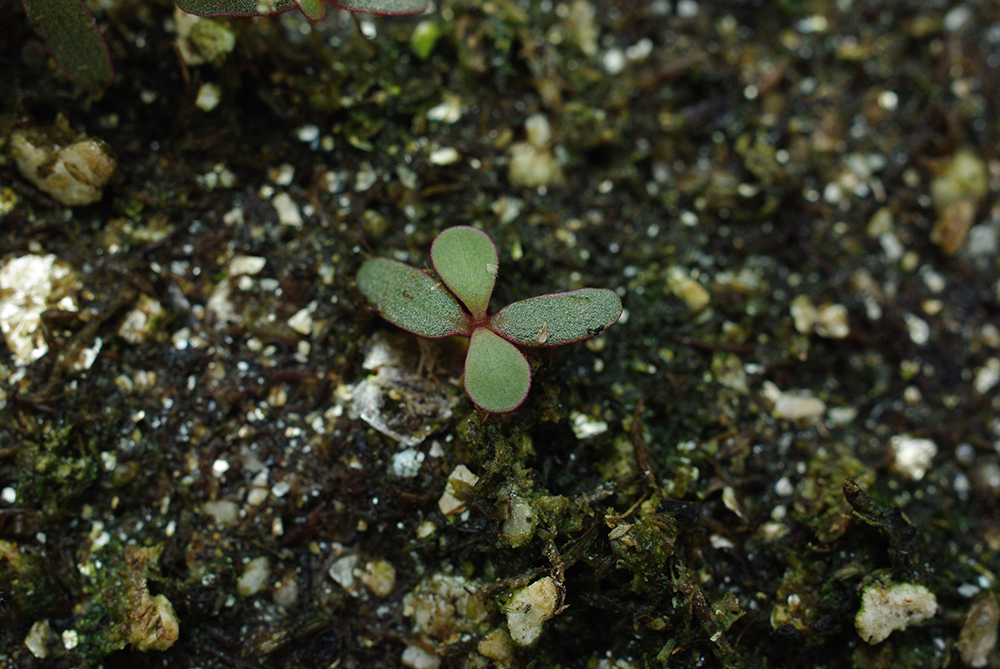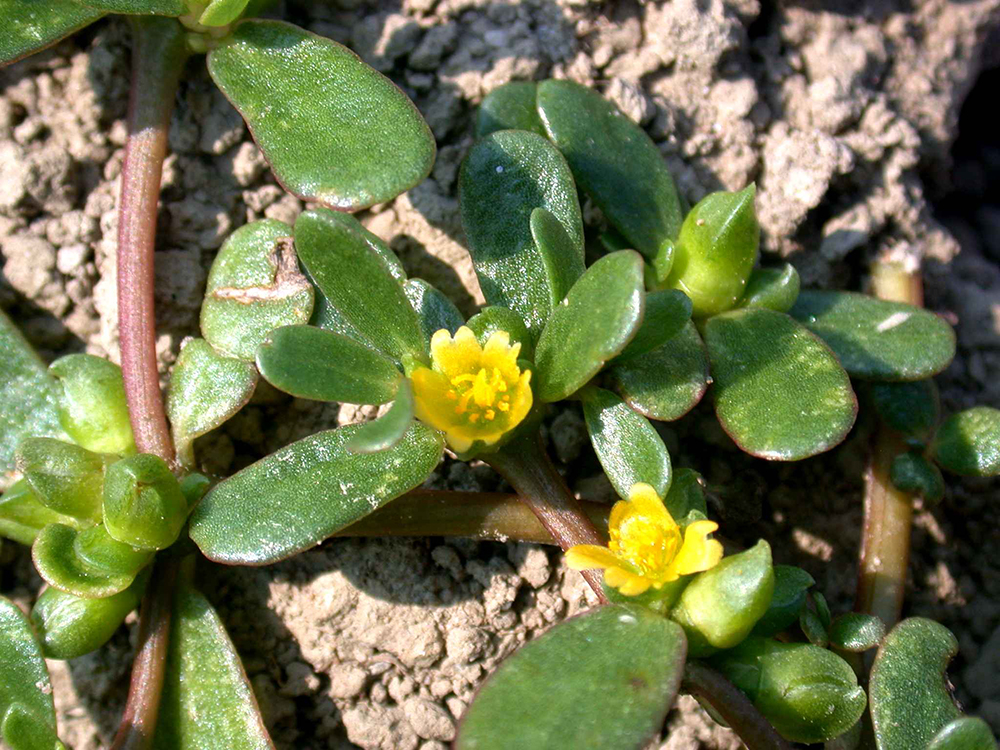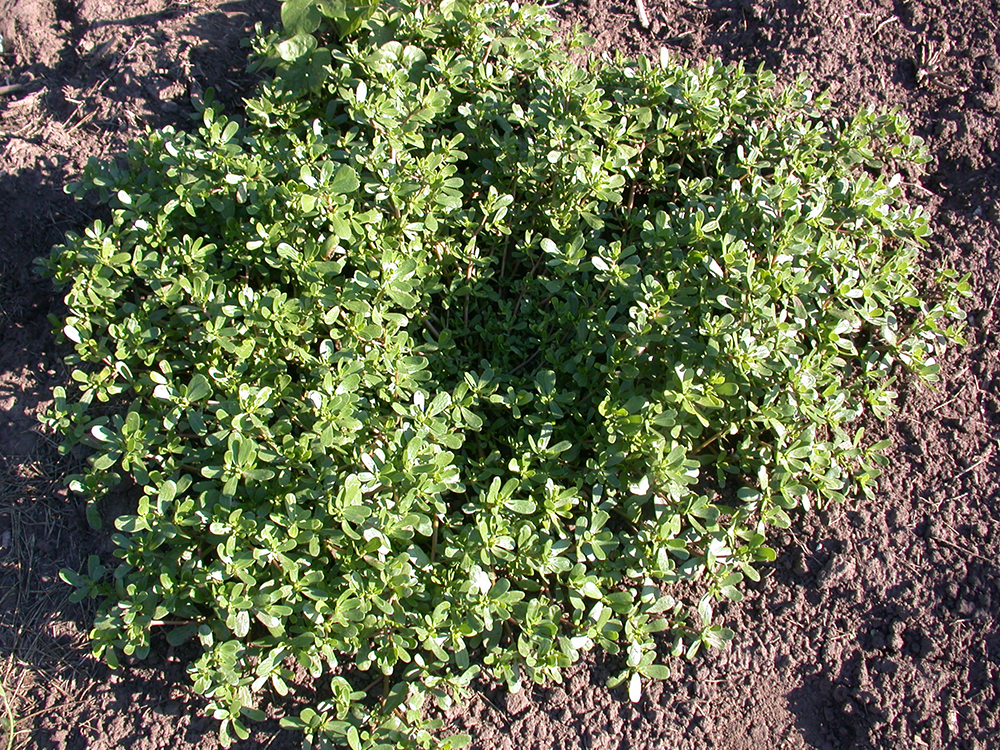Other common names: pusley, purslane, pursley, wild portulaca, low pigweed, common portulaca, wild portulac, little hooweed



Portulaca oleracea L.
Identification of Purslane
Family: Purslane family, Portulacaceae
Habit: Succulent, prostrate, taprooted summer annual herb
Description: Young seedling stems begin upright, reaching 0.5 inch in height, then become prostrate. Stems and cotyledons are maroon tinged and fleshy. Cotyledons are 0.08–0.4 inch long by 0.04–0.08 inch wide and oblong. First true leaves are 0.5–1 inch long, fleshy, smooth and green with maroon hued undersides. The first six to 10 true leaves are opposite. Mature plants are succulent, crawling and grow prostrate in 2–3 foot diameter circles. Stems are highly branched, round, fleshy and turn maroon with age. Leaves are club shaped, round-tipped, fleshy, green, hairless and smooth. Leaves may be alternate or opposite and sometimes have red margins. The root system consists of a thick taproot with secondary fibrous roots. Yellow, five-petaled flowers, 0.13–0.4 inch in diameter, are present individually in leaf axils and branch junctions, and in clusters on terminal branch ends. Flowers open only in sunny weather. Seeds are black, flat, round to kidney shaped and small (less than 0.04 inch in diameter), with a bumpy surface. Seeds develop in 0.25 inch diameter globe-shaped capsules that split horizontally to release the seeds upon maturity.
Similar species: Horse purslane (Trianthema portulacastrum L.) is also a prostrate succulent, but it has stalked leaves and pinkish purple flowers. Common purslane is sometimes confused with prostrate pigweed (Amaranthus blitoides S. Watson), prostrate knotweed (Polygonum aviculare L.) and various spurges (Euphorbia spp.). Prostrate pigweed has non-fleshy leaves, which distinguish it from common purslane. Prostrate knotweed can be distinguished by the presence of papery appendages (ocreae) wrapping the stem above each leaf. Spurges release a milky, white sap when cut.
Management of Purslane
Because newly emerged common purslane seedlings are very small and fragile, stirring the top 1–2 inches of soil with tillage implements two to four times after the soil warms is highly effective at removing most of the individuals that will emerge during the season. Cultivation of large plants is often ineffective because the plants reroot or set seed without rerooting. Thus, cultivation of plants beyond the cotyledon stage should aim at burial rather than breakage or uprooting. Although stem fragments can develop new root systems, studies have shown that this requires several weeks and that the resulting individuals are less vigorous and produce fewer seeds than new seedlings that germinate in response to the cultivation. Flame weeding kills seedlings, but large plants recover unless unusually long exposure times are used.
Organic mulch materials are highly effective for suppressing common purslane. Because the species is susceptible to rotting under continuously shady, humid conditions, and because of its prostrate growth form, less mulch is required to control common purslane than for most other annual weeds. Due to its shade intolerance and prostrate growth form, dense planting helps control this weed in crops that will tolerate high density and that grow quickly. Rapid coverage of the ground is critical, however, because even small, dying plants can set seed.
Common purslane requires high nutrient levels for rapid growth. In particular, it is more responsive to P than some vegetable crops like lettuce. Continuous reliance on manure derived compost as an N source for vegetable production leads to P accumulation, and this appears to foster problems with common purslane.
Because the seeds are highly persistent in the soil, removal of plants that escape control before they set seed is useful for long-term control. Since flowers can self-pollinate without opening, plants can set seed while still appearing to be immature.
Ecology of Purslane
Origin and distribution: Common purslane probably originated in South America and spread into North America with Native American agriculture. It may, however, have originated in North Africa and spread to eastern North America with European colonization. It currently occurs throughout the United States and southern Canada, and has a worldwide distribution, except at latitudes above 60° N.
Seed weight: 0.08–0.15 mg.
Dormancy and germination: Some seeds are capable of germination immediately after falling from the capsule, although dormancy develops as seeds mature. Light is usually required for germination of freshly shed seeds, but germination in the dark becomes more likely as the seeds age. Initially, the species germinates best when soil temperatures exceed 86°F. This temperature requirement lowers to 68°F, however, as spring progresses. Germination of aged seeds is better at alternating than at constant temperatures. Light filtered through a leaf canopy inhibits germination. Nitrate promotes germination of seeds in the dark. Germination is not affected across a pH range of 5–9.
Seed longevity: Common purslane seeds have germinated after 30–40 years of burial. In several annually tilled soils in New Zealand seeds declined by 29% per year. On three soil types in a tilled small grain-fallow rotation in Saskatchewan, the common purslane seed bank declined by 17–27% per year. Seed decline in a Mississippi soil was approximately 60% per year in untilled soil and 76–87% per year in tilled soil. Seeds of common purslane remained viable after soil was solarized with a daily maximum of 149°Fm and 30% survived continuous cooking of moist soil at 140°F.
Season of emergence: Most seedlings begin emerging in late spring when maximum air temperature exceeds 86°F and rain is adequate, and they continue to emerge during the heat of the summer.
Emergence depth: Common purslane emerges best when the seeds are at the soil surface, provided the soil is moist. Emergence declines rapidly for seeds placed deeper, and seedlings do not emerge from seeds deeper than 1 inch in the soil.
Photosynthetic pathway: C4
Sensitivity to frost: Common purslane is very sensitive to frost and sometimes even dies from chilling prior to the first frost.
Drought tolerance: This species is extremely drought tolerant due partially to water storage in the succulent leaves and stems. It also has small stomates and a waxy outer layer on the leaves, both of which reduce water loss from the leaves. Under extreme drought conditions, the plants shed their leaves and grow new ones when water again becomes available.
Mycorrhiza: Common purslane is not mycorrhizal.
Response to fertility: Common purslane is most problematic on highly fertile soils. The species shows a linear increase in growth up to N levels of 133 pounds per acre. It responds to N, P and K but responds most to P. The species shows a strong response to available phosphorus, and competition for phosphorus is the apparent cause for competitive suppression of lettuce by this species. The species is found on soils with a pH of 5.6–7.8.
Soil physical requirements: Common purslane grows best on sandy soils but tolerates a wide range of soil textures on well-drained soils. It establishes best on finely prepared seedbeds. It is relatively tolerant of saline soils, partially because of its capacity to produce antioxidant compounds.
Response to shade: Common purslane grows slowly in shade, and since the plant has a prostrate growth form, it is a poor competitor for light. Under moist shady conditions, the species is prone to fungal diseases. Even dying plants can set seed, however.
Sensitivity to disturbance: Common purslane germinates in response to environmental cues that are associated with tillage (light, warm soil, nitrate). Soil disturbance during summer generally results in a flush of new seedlings, and consequently, it commonly occurs in vegetable fields and gardens. Because it is succulent, common purslane does not die easily following uprooting. It may then reroot or continue to mature and set seeds even without contact with the soil. The plant fragments easily, and the pieces can develop new root systems from stem fragments, but only stem fragments with nodes produce new leaves, and the presence of leaves on the fragment improves survival and new leaf growth.
Time from emergence to reproduction: Plants flower four to eight weeks after emergence and set seeds seven to 16 days later. Plants emerging in mid-summer can flower within two to three weeks of emergence. Consequently, the species can complete two or more generations per year. Seeds mature on main branches first and subsequently on secondary branches, giving a sequential production of seeds from individual plants throughout the season.
Pollination: The species is primarily self pollinated. Flowers open in the morning on bright, hot days, and if conditions are not suitable for opening, the flowers can successfully self-pollinate and turn to mature capsules without opening.
Reproduction: Flower buds form in the axils of leaves. The capsules look very much like the flower buds. Consequently, plants commonly appear to go from a pre-reproductive state to seed shed overnight. One foot diameter plants produce about 7,000 seeds, but a large plant may produce over 100,000 seeds. Undisturbed common purslane does not spread vegetatively, but plant fragments created during cultivation can reroot.
Dispersal: The seeds have no apparent adaptations that aid dispersal, and they fall directly onto the ground around the capsule. The principal mode of dispersal is probably in soil clinging to shoes, tires and machinery. Seeds have been recovered from cattle manure, deer feces and bird feces, and occasional dispersal to new sites by animals may occur.
Common natural enemies: A sawfly, Sofus pilicornis, mines the leaves. A white rust, Albugo portulacae, commonly attacks common purslane and can destroy plants under favorable conditions.
Palatability: Common purslane is edible as a salad vegetable or pot herb. The digestibility, protein content and mineral content is higher than that of most other weed species. The plant is particularly rich in omega-3-fatty acids, vitamin E and vitamin C. An upright growing cultivar has been developed. However, livestock fed large amounts of common purslane can develop nitrate and oxalate poisoning.
Summary Table of Purslane Characteristics
| Common groundsel | ||||||||
|---|---|---|---|---|---|---|---|---|
| Growth habit | Seed weight (mg) | Seed dormancy at shedding | Factors breaking dormancy | Optimum temperature for germination (F) | Seed mortality in untilled soil (%/year) | Seed mortality in tilled soil (%/year) | Typical emergence season | Optimum emergence depth (inches) |
| prostrate | 0.08–0.15 | No | li, at, ni | 86–95 | 60 (hot climate) | 17–29 (cool climate) 76–87 (hot climate) | late spring to summer | 0–0.1 |
| Photosynthesis type | Frost tolerance | Drought tolerance | Mycorrhiza | Response to nutrients | Emergence to flowering (weeks) | Flowering to viable seed (weeks) | Pollination | Typical & high seed production (seeds per plant) |
| C4 | low | high | no | high | 2–8 | 1–2 | self | 10,000 & 100,000 |
Table Key
General: The designation “–” signifies that data is not available or the category is not applicable.
Growth habit: A two-word description; the first word indicates relative height (tall, medium, short, prostrate) and second word indicates degree of branching (erect, branching, vining).
Seed weight: Range of reported values in units of “mg per seed.”
Seed dormancy at shedding: “Yes” if most seeds are dormant when shed, “Variable” if dormancy is highly variable, “No” if most seeds are not dormant.
Factors breaking dormancy: The principle factors that are reported to break dormancy and facilitate germination. The order of listing does not imply order of importance. Abbreviations are:
scd = seed coat deterioration
cms = a period subjected to cold, moist soil conditions
wst = warm soil temperatures
li = light
at = alternating day-night temperatures
ni = nitrates
Optimum temperature range for germination: Temperature (Fahrenheit) range that provides for optimum germination of non-dormant seeds. Germination at lower percentages can occur outside of this range. The dash refers to temperature range, and the slash refers to alternating day/night temperature amplitudes.
Seed mortality in untilled soil: Range of mortality estimates (percentage of seed mortality in one year) for buried seeds in untilled soil. Values were chosen where possible for seeds placed at depths below the emergence depth for the species and left undisturbed until assessment. Mortality primarily represents seed deterioration in soil.
Seed mortality in tilled soil: Range of mortality estimates (percentage of seed mortality in one year) for seeds in tilled soil. Values were chosen for seeds placed within the tillage depth and subjected to at least annual tillage events. Seed losses are the result of dormancy-breaking cues induced by tillage, germination and deterioration of un-germinated seeds.
Typical emergence season: Time of year when most emergence occurs in the typical regions of occurrence for each weed. Some emergence may occur outside of this range.
Optimum emergence depth: Soil depths (in inches below the soil surface) from which most seedlings emerge. Lower rates of emergence usually will occur at depths just above or just below this range.
Photosynthesis type: Codes “C3” or “C4” refer to the metabolic pathway for fixing carbon dioxide during photosynthesis. Generally, C3 plants function better in cooler seasons or environments and C4 plants function better in warmer seasons or environments.
Frost tolerance: Relative tolerance of plants to freezing temperatures (high, moderate, low).
Drought tolerance: Relative tolerance of plants to drought (high, moderate, low).
Mycorrhiza: Presence of mycorrhizal fungi. “Yes” if present; “no” if documented not to be present, “unclear” if there are reports of both presence and absence; “variable” if the weed can function either with or without, depending on the soil environment.
Response to nutrients: Relative plant growth response to the nutrient content of soil, primarily N, P, K (high, moderate, low).
Emergence to flowering: Length of time (weeks) after emergence for plants to begin flowering given typical emergence in the region of occurrence. For species emerging in fall, “emergence to flowering” means time from resumption of growth in spring to first flowering.
Flowering to viable seed: Length of time (weeks) after flowering for seeds to become viable.
Pollination: “Self” refers to species that exclusively self-pollinate, “cross” refers to species that exclusively cross-pollinate, “self, can cross” refer to species that primarily self-pollinate, but also cross-pollinate at a low rate, and “both” refers to species that both self-pollinate and cross-pollinate at relatively similar rates.
Typical and high seed production potential: The first value is seed production (seeds per plant) under typical conditions with crop and weed competition. The second value, high seed production, refers to conditions of low density without crop competition. Numbers are rounded off to a magnitude that is representative of often highly variable reported values.
Further Reading
Mitich, L.W. 1997. Common purslane (Portulaca oleracea). Weed Technology 11: 394–397.
Miyanishi, K. and P.B. Cavers. 1980. The biology of Canadian weeds. 40. Portulaca oleracea L. Canadian Journal of Plant Science 60: 953–963.
Proctor, C.A., R.E. Gaussoin and Z.J. Reicher. 2011. Vegetative reproduction potential of common purslane (Portulaca oleracea). Weed Technology 25: 694–697.
Santos, B.M., J.A. Dusky, W.M. Stall, T.A. Bewick, D.G. Shilling and J.P. Gilreath. 2004. Phosphorus absorption in lettuce, smooth pigweed (Amaranthus hybridus) and common purslane (Portulaca oleracea) mixtures. Weed Science 52: 389–394.

